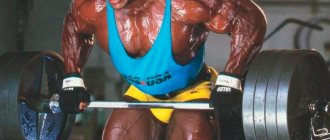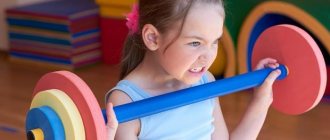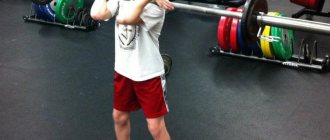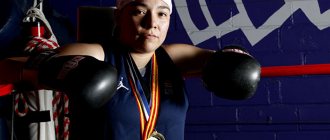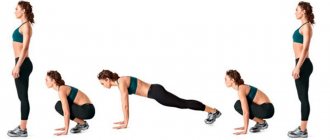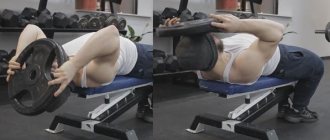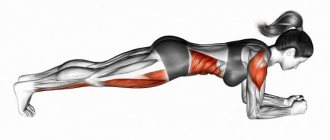People go to the gym for different purposes. Some want to lose weight. Others want to gain muscle mass. There are men and women who start going to the gym with the goal of creating a beautiful, pumped up, sculpted body. A special category of trainees consists of athletes who, during one workout, bench, lift, and pull enormous weights. They are working on increasing strength. Such activities require a thorough multifaceted approach.
Features of strength training
Strength training involves working with heavy weights. High repetitions, blocks and isolation exercises are foreign to athletes whose training is aimed at developing strength. Naturally, such exercises as, for example, lat pull-downs in a machine or leg press in a machine may well be present in the training process, but as an additional load and not even in every workout.
The main features of strength training:
- Training aimed at developing strength mainly consists of compound exercises.
- The main feature of such training is to reduce repetitions. Typically, the exercise is performed up to five repetitions.
- The number of approaches, compared to the usual training to increase muscle mass, is greater. There may be 6-8 of them.
- The rest time between approaches also increases and ranges from three to five minutes. The rest period may last longer.
- Also, to achieve the effect, exercises are used to develop explosive strength. It's a push and pull.
- The amount of training to develop strength will depend on the working weight. For example, if the weight is 100 percent of your one-repetition maximum (1RM), then the workout that includes that exercise should be done once a week. If the weight is lower, for example, 80 percent of the one-rep maximum, then training can be done twice a week.
- Such training should not be carried out more than once every four days.
- Also, you should observe the speed of the exercise. It usually goes from medium to low. This is necessary so that the body does not get used to the load.
But aerobic exercise is completely irrelevant in the training mode to increase strength.
Particular attention should be paid to the technique of performing the exercises. Firstly, due to correct execution, the risk of injury is reduced, and secondly, the correct technique increases the innervation of the muscles (creates a larger number of nerve endings), accordingly, we get a powerful and better muscle response in all the aspects we need.
To develop strength, use the ladder technique , in which the weight increases with each subsequent approach, and the last approaches are performed with maximum weight (either 80% of the maximum or 100%).
To “break through” the stop in strength development that all athletes encounter, presses with a pause along the movement may be relevant. For example, when performing a bench press: the bench press and lowering of the bar are performed with fixation at the center of the amplitude.
Additional exercises can also be added, which were already discussed at the beginning, these are exercises in simulators, and work with dumbbells, and other types of exercises.
Exercises to develop strength abilities
Essay
On the topic “ A set of physical exercises to develop a student’s strength abilities ”
INTRODUCTION
The development of strength abilities plays a very important role in the formation of personality. In addition, people with good physical fitness are more resilient and have good health.
Strength is a person's ability to overcome external resistance or counteract it through the use of muscular effort.
Strength is one of the components of the structure of physical abilities that determine its various manifestations.
Excessive use of exercises aimed at developing maximum strength can lead to an increase in muscle mass and weight. To avoid this, it is necessary to perform speed-strength exercises. Relative strength is the amount of force per kg of human weight. This indicator is important to take into account when high jumping, in artistic gymnastics, and also as an objective indicator of the strength readiness of various athletes.
The purpose of the work is to consider the strength training of students in higher educational institutions within the framework of physical education classes. Based on the goal, the following tasks can be identified:
— consider the essence and direction of strength training;
- prepare sets of strength exercises and their dosage.
Chapter 1. Strength training. Essence and direction.
Strength should be understood as a person’s ability to overcome external resistance due to muscle efforts (contractions) or to counteract external forces. Strength is one of the most important physical qualities in the vast majority of sports, so athletes pay exceptional attention to its development.
Muscle strength largely determines a person’s health and performance. Insufficient strength training is the most acute problem in people’s physical fitness. In the existing system of physical education, strength training and exercises with weights do not have optimal application, sufficient material and scientific-methodological support.
One of the promising directions for improving the system of physical education of students is the use of elements of popular sports among young people in the structure of classes. The lesson program should be drawn up taking into account the characteristics of the motivational sphere, physical education and sports interests, the level of health and physical fitness of students.
The process of strength training is aimed at developing various strength abilities, increasing active muscle mass, strengthening connective and supporting tissues, improving physique and increasing the ability of those involved to realize strength abilities in training conditions.
Any sports training significantly changes the functions and structure of the body. During strength training, the body's adaptive response to stress is expressed in the growth of skeletal muscles and an increase in strength.
1.2 Means and methods for developing strength abilities
One of the most significant aspects that determine muscle strength is the mode of muscle activity.
The means of developing muscle strength are various strength exercises, among which three main types can be distinguished:
1. Exercises with external resistance.
2. Exercises with overcoming your own weight.
3. Isometric exercises.
Exercises with external resistance are one of the most effective means of developing strength and are divided into:
1) Exercises with weights, including on machines, which are convenient due to their versatility and selectivity. With their help, you can predominantly influence not only individual muscles, but also individual parts of muscles;
2) Exercises with a partner, which can be used not only during training sessions and training in gyms, stadiums, arenas, but also in the field. These exercises have a beneficial emotional effect on those involved;
3) Exercises with resistance from elastic objects (rubber shock absorbers, tourniquets, various expanders, etc.), which are advisable to use in independent classes, especially during morning physical exercises. Their advantage lies in their low dead weight, small volume, ease of use and transportation, and a wide range of effects on various muscle groups;
4) Exercises in overcoming environmental resistance are effective when training in accelerated movement and strength endurance (for example, running uphill or on sand, snow, water, against the wind, etc.), for special strength training for hand-to-hand combat (on ice , sand, in water, etc.).
Bodyweight exercises are widely used in all forms of physical training.
They are divided into:
1) Gymnastic strength exercises: lifting by inversion and force, pulling up with a different grip on the crossbar, push-ups on hands while lying down and on parallel bars, lifting legs to the crossbar, climbing a rope, pole and many others;
2) Athletics jumping exercises: single and “short” jumping exercises, including up to five repeated take-offs, “long” jumping exercises with multiple take-offs over segments of 30-50 meters, jumping over athletics hurdles, deep jumps from a hill followed by take-off ;
3) Exercises in overcoming obstacles (fence, wall, destroyed stairs, ditch, etc.) on special training strips.
If there are only two muscle reactions to irritation - contraction with a decrease in length and isometric tension, the results of the exerted effort turn out to be different depending on the mode in which the muscles work. Therefore, in the process of performing sports or professional techniques and actions, a person can lift, lower or hold heavy loads. At the same time, the muscles providing these movements work in different modes.
If, overcoming any resistance, the muscles contract and shorten, then their work is called overcoming (concentric). Muscles that resist any resistance can, when tense, lengthen, for example, holding a very heavy load. In this case, their work is called inferior (eccentric). Overcoming and yielding modes of muscle work are combined under the name dynamic.
Chapter 2. A set of exercises for developing strength abilities
Complex No. 1
| № | Contents of the exercise | Dosage (number of times/duration) | Notes and guidelines |
| 1 | Pull-up: Standing, grab the bar with your hands, pull your torso towards it several times without jerking or swinging your legs, your chin should be higher than the bar | Repeat 7-10 times. | Over time, you can increase the number of straight-legged pull-ups, and when the muscles of your arms and abdominals are significantly stronger, you can hold your legs in the “angle” position, which puts additional stress on the muscles of the legs and back. |
| 2 | Raising and lowering legs while hanging : Pull your chin above the bar, slowly raise your straight legs to the “angle” position, lower. | Repeat the exercise 5 - 10 times. | The legs should be brought together. Lifting should be done at a moderate pace, and lowering the legs down should be done at a slower pace. |
| 3 | Circular swings of the left (right) leg over the back of the chair: Starting position: stand facing the back of a chair, standing at a distance of about 1 m, spread your arms to the sides. Describe a circle to the right with your left leg, without bending your legs. | Repeat the exercise 6-8 times with each leg in 2-3 approaches. | Perfectly strengthens the abdominal muscles. Breathing during the exercise should be voluntary, the pace should be from slow to medium. |
| 4 | Lying push-ups : Starting position: put your feet on a chair. Bend and straighten your arms. At the same time, do not bend your legs or lower your pelvis. | Repeat the exercise 10 - 20 times. | Strengthens and develops the chest muscles, lats and triceps. Exhale when bending your arms, and inhale when straightening. |
| 5 | Raising legs from a supine position: Starting position: lying on your back. Raise your legs up and lower them behind your head, trying to touch your toes to the floor. Return to starting position. | Repeat the exercise 5 - 10 times. | Will strengthen the abdominal muscles. Inhale while lying down. Exhale while lowering your legs behind your head. |
| 6 | Wide-arm push-ups: Starting position: place your arms bent on the floor and do push-ups while lying down. | If you have athletic training, do 10–15 repetitions for 3–5 approaches. | To shape and strengthen the triceps. Inhale when extending your arms, exhale when bending your arms. |
| 7 | Jumping on a gymnastic bench : Starting position: main stance at the end of the gymnastic bench. Pushing off from the bench, perform a five-step jump from one foot to the other. | Repeat 3-4 times. | Emphasis on the raking movement with the leg. Perform at a medium to fast pace. |
| 8 | Jumpinguppush both but G: Starting position: stand on a chair. Jump to the floor and jump up as high as possible at a fast pace. | Repeat 7-10 times. | Strengthens the muscles of the pelvis and legs. When performing, maintain an average pace, breathing freely. |
| 9 | Squat on one leg on a chair : Starting position: stand with one leg on a chair, lower your arms along your body. Squat down on your entire foot. | Repeat the exercise 10 times in 2-3 approaches. | Strengthens leg muscles. Inhale when squatting, exhale when straightening. The pace of the exercise should be slow. |
| 10 | Raising the torso until the lower back bends: Starting position: lie with your hips on a stool, face down, fix your feet, bend your arms at the elbows behind your head. First, lean forward, then bend at the waist. | Do 10-20 repetitions. | Strengthens the extensor muscles of the torso. Exhale - when bending, inhale - when raising the body, pace - from moderate to medium. |
Complex No. 2 (with a partner)
| № | Contents of the exercise | Dosage (number of times/duration) | Notes and guidelines |
| 1 | Standing opposite your partner at a distance slightly more than your arms outstretched forward. Pushing the palms of straightened arms into the chest of a leaning partner. | Repeat 10-14 times. | Active hand movements; keep your back straight; breathing is arbitrary |
| 2 | Lying on your back, grab the partner standing behind your head by the ankles. Raising straight legs up and lowering them with braking. | Repeat the exercise 10 - 16 times. | Compensating for the force of the partner pushing the legs forward and down; legs tense, straight |
| 3 | Sitting on the floor, rest your legs spread to the sides “foot to foot”, and grab each other’s fingers with your hands (alternate pull with your back, as when rowing, overcoming the resistance of your partner) | Repeat the exercise 14-18 times. | According to possible amplitude; active movements; do not bend your knees; keep your back straight. |
| 4 | Standing leaning forward, holding the support with your hands, one leg slightly bent at the knee joint, back and down (bending the hip forward, overcoming the partner’s resistance) | Repeat the exercise 8 - 12 times. | Perform the exercise sequentially with one leg, then the other. |
| 5 | Standing with your feet shoulder-width apart, grab the hands of your squatting partner by the wrist joints (pull your partner’s hands up toward you) | Repeat the exercise 8 - 12 times. | Try to lift your partner up; maintain balance; breathing is arbitrary |
| 6 | Standing, feet shoulder-width apart, lean your back against your partner’s back (simultaneous squats, overcoming the weight of your partner’s body) | Repeat the exercise 10 - 16 times. | Move your legs forward half a step, cross your arms over your chest |
| 7 | Sitting in support from behind, with the feet of your half-bent legs resting on the feet of a partner sitting opposite in the same position (alternating leg press, overcoming the resistance of the partner) | Repeat 14-18 times. | Keep your back straight; do not make sudden movements; breathing is arbitrary |
| 8 | Sitting on the carpet with your back to each other, grabbing your partner with your hands “under the elbows” (wrestling with your partner, trying to lay him sideways on the carpet) | Repeat 6-10 times. | Maintain safety precautions; do not make sudden movements. |
CONCLUSION
Thus, muscle loads stimulate brain activity and maintain the desired tone. This means that for successful mental activity a person needs not only a trained brain, but also a trained body. After all, only 10% of brain cells are directly occupied by mental activity, and the remaining 90% control the work of muscles and movements. This is why impulses from muscles are important for “thinking” cells. Experiments conducted in our country and abroad have clearly shown that students with developed muscles learn more easily. They get tired less, recover faster, and manage to do more than their peers. At the same time, trained muscles protect against accidental injuries and provide a margin of safety during physical work. And in the conditions of scientific and technological progress, trained muscles are the reserve that helps a person withstand the onslaught of emotional overload, maintain health and high performance.
Over the past decades, positive results have been obtained from studies of the training process of young weightlifters, which generally showed that with a correct, methodologically competent approach and effective control, weight training in adolescence does not lead to any adverse consequences in the health of athletes, and most importantly, does not retard growth.
List of sources used.
- Druz V A. Modeling the process of sports training. - Kyiv: Health, 1967. - 96 p.
- Dikul V.I. How to become strong // Physical education at school. - 1990.-No.N.-S.46-49.
- Matveev L.L. Fundamentals of sports training. - Y:. FiS, 1977-217 p.
- Oppavin S.M., Ginaev Yu.T. Physical culture in human life. L.: Knowledge. 1987.
- Shustin B.N. On the development of “models of the strongest athletes” // Management of the training process for athletes of the highest ranks. L., 1976, p. 119-120.
- Polyakov V A Kettlebell sport. Toolkit. M.: Physical culture and sport, 1988.
- Petrov V.K. Everyone needs strength. Y:. Physical education and sport, 1984.
- Nasledov.A. In the book; "Mechanisms of control of muscle activity." -L.: Science, 1985, pp. 209-223.
- Matveev L.P. Theory and methodology of physical culture. - M.: Physical culture and sport, 1991.
- Godik M.A. Study of the factor structure of human speed-motor abilities: Author's abstract. Ph.D. dis. M.. 1966. - 22 p.
Who needs muscle strength training and when?
In addition to weightlifting athletes, powerlifters and athletes of various bench press competitions, strength training is relevant for bodybuilders who, with its help, overcome the “plateau” in achievements when the usual training and nutrition are no longer able to increase the volume and mass of muscles.
These exercises are also performed by some athletes in other sports, for example, as always, a brilliant example is American football players. Of course, although the training of football players consists of exercises aimed at increasing strength indicators, nevertheless, the training is aimed at the overall development of indicators.
How to choose the right weight
Working with extreme weights to failure means an increased risk of injury.
When training for strength, it is not customary to perform a set to muscle failure.
Therefore, when volumetric loads are performed (number of approaches 3-5), working weights are selected with a margin of 1-3 repetitions.
For example, you need to do 5x5 squats. In this case, take a weight with which you can squat 8 times (reserve 3 repetitions).
When performing intense loads for 1-2 repetitions, the maximum weight for a given repetition range is used. At the same time, for safety reasons, insurance is required for assistants.
All of the above applies to the squat, press and deadlift.
For the other exercises in the sample program, use weights that will allow you to complete the upper rep range in the first week. And gradually, from week to week, increase the weight and drop down to the lower range.
How long to rest between sets
At first, because the weights are light, you won't need much rest. But when the weight starts to increase, it may take longer to recover from a set.
- 1.5 minutes if you finished the last set without much effort.
- 3 minutes if you had to work hard to finish the set.
- 5 minutes if you reach muscle failure on the last rep.
You can also navigate by your breathing. If you experience shortness of breath during exercise, rest until it is completely restored.
How to gain arm strength without special equipment
It is important to understand that excellent results for working on your body cannot necessarily be obtained solely by visiting the gym. Some people don’t have time for this, some have money for a subscription to a fitness club, and others are simply embarrassed to come to the abode of jocks with nothing.
Therefore, the only way out of this situation is to start training at home, and after a month go to the gym. Dumbbells will help you with this. Check out an example of a basic arm workout with an emphasis on biceps.
This complex can be performed once a week during the preparatory period.
Content
- 1 Strength training without gaining muscle mass 1.1 1st commandment: perform low repetitions, saving strength!
- 1.2 2nd commandment: use Hebb's law - practice the movements as often as possible!
- 1.3 3rd commandment: develop joint work of muscles!
- 1.4 4th Commandment: Stretch!
- 1.5 5th Commandment: Learn the ancient art of breath control!
- 1.6 6th Commandment: Train
- 1.7 7th commandment: pay attention to weak links!
- 1.8 8th Commandment: Use the principles of synoptic facilitation!
- 1.9 9th commandment: do plyometric exercises to overcome nervous inhibition (that is, sometimes move faster)!
- 1.10 10th commandment: train the power of consciousness! 1.10.1 Arousal
- 1.10.2 Faith
- 1.10.3 Visualization
- 1.10.4 Motivation
- 1.10.5 Imagination
Plateau: what to do when there is no progress
The first thing to do if you fail to complete a set is to rest longer. Place the bar down and wait 5 minutes and then try again.
If it doesn't work this time, check if there are any errors:
- Have not warmed up well: a lack of warm-up approaches forces you to exercise on cold muscles, and an excess of them tires them.
- They did it with bad technology. Incorrect bar trajectory increases the risk of failure.
- Missed training. If you don't load your muscles consistently, you don't grow.
- Did too much cardio or extra exercise, which slowed down your recovery.
- Didn't get enough sleep. Lack of sleep slows recovery.
- We didn't eat. Lack of nutrients also slows down recovery.
If you can't complete all sets and reps for three workouts in a row, you may want to reduce the weight or number of sets and reps.
The Progress Equation: How to Train to Get Results →
How to reduce the load
You will not be able to gain weight constantly; sooner or later the process will stop. If the working weight does not increase for three workouts in a row, reduce the load as follows:
- Three sets of five reps.
- Three sets of three repetitions.
- One set of three reps and two sets of three reps with -5% of the weight.
You can also reduce the weight by up to 10% of the working weight and add it again, monitoring the technique and correcting your mistakes.
What are the goals and timing of the training program?
| Beginners | Advanced I | Advanced II | Professionals | |
| Squats | 100 kg | 140 kg | 160 kg | 180 kg |
| Bench press | 80 kg | 100 kg | 110 kg | 120 kg |
| Deadlift | 140 kg | 180 kg | 200 kg | 225 kg |
| Standing barbell press | 45 kg | 60 kg | 70 kg | 80 kg |
| Bent-over barbell row | 70 kg | 90 kg | 100 kg | 110 kg |
| How long will it take | 1–6 months | 4–12 months | 6–18 months | 1–2 years |
